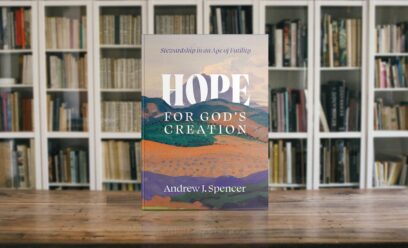What Does it Mean to Live in a Secular Society?

This article first appeared in the Summer 2022 edition of the Social Issues Bulletin. Download the whole Bulletin.
When we hear the term ‘secular society’, what comes to mind? Maybe it is the sense that slowly but surely talk and thought about God are being squeezed out of the public arena, or in the words of Tony Blair’s advisor, Alistair Campbell, ‘We don’t do God’ anymore. Perhaps it is a term which has become synonymous with godlessness, moral confusion and open hostility towards the Christian faith. Or it could be that when the phrase is mentioned certain well known individuals spring to mind which for us embody the anti-god zeitgeist – Richard Dawkins and Sam Harris in academia or Stephen Fry and Daniel Radcliffe in the media. If that is the case, then there will be a tendency for us to see secularism and a secular culture as a threat which in turn will cause us to adopt a defensive posture, feeling we have to be apologetic for what we believe and maybe in our defensive become aggressive with others for what they believe or don’t believe. The upshot is that the secular society becomes a kind of gladiatorial arena involving combat between people of faith on the one hand and unbelievers on the other.
But suppose on closer inspection we begin to see things a little differently, with an understanding that secularity is our context in the West, which while embodying elements of human rebellion and sin, as well as the operation of the ‘principalities and powers’, nonetheless we see it also as providing opportunities for Gospel proclamation and, under God’s Spirit, Gospel transformation.
It is this possibility we shall explore as we ask, ‘What does it mean to live in a secular society?’
What is a ‘secular society’?
In order to answer that question adequately, we need to get our thinking clear on exactly what we mean by ‘secular society’.
To do this we need to get a few definitions carefully tucked under our belts.
The first one is the term ‘secular’ which is derived from the Latin root ‘saeculum’, meaning the present age. So, in some ways the focus of the secular is on how we live in the ‘here and now’ without much reference to any transcendent realm or life beyond the grave.
This has led to two definitions of ‘secular’.[1]
First, there is the classic definition, whereby the ‘secular’ is to be distinguished from the ‘sacred’. Here the ‘secular’ refers to the domestic life, the work of butchers, bakers and candlestick makers, whereas the ‘sacred’ refers to the religious sphere occupied by monks, priests, and nuns. We can call this Secular (1) – the sacred/secular divide.
We then come to Secular (2), a modern understanding with which we are more familiar. This sees the need for society to be essentially areligious, to be an allegedly neutral, religious free public space.
Furthermore, associated with this is secularism which as a world view rejects in principle the existence of any transcendent or spiritual dimension and would seek to restrict, if not entirely remove, the influence of religion from the affairs of society.
This brings us to another important term – secularisation which Os Guinness defines as ‘…the process through which, starting from the centre and moving outwards, successive sectors of society and culture have been freed from the decisive influence of religious ideas and institutions.’[2] D. A. Carson shows how all three relate to each other: ‘In more popular parlance… all three words ‘secular,’ ‘secularisation,’ and ‘secularism’ – have to do with the squeezing of the religious to the periphery of life. More precisely, secularisation is the process that progressively removes religion from the public arena and reduces it to the private realm; secularism is the stance that endorses and promotes such a process.’[3]
Tied to Secular (2) is the idea that as cultures experience modernisation through technological advancement, religious belief and participation correspondingly decline. Not only so but over time, personal piety itself will eventually wither on the vine. This means that a truly secular society will be a less religious society. This has come to be known as the Secularisation Thesis. And so back in 1968 Peter Berger announced that by ‘…the 21st century, religious believers are likely to be found only in small sects, huddled together to resist a worldwide secular culture.’[4]
How would this happen? Well, one of the main driving forces in the secularising process is what Max Weber calls rationalisation. This simply means religious ideas becoming less and less meaningful and religious traditions becoming more and more marginal as they are replaced by other modes of thinking and traditions. With the advance of modernity, it is argued, less space is reserved for God. So, if you are ill you call a physician not a priest; if you want good crops you get a better fertiliser, you don’t offer sacrifices to appease an angry deity. Put simply, ‘superstitious’ religious thinking and behaving are replaced with rational/scientific ways of thinking and behaving.
One of the major features of this change in picturing the world is what is called disenchantment, where the ‘magic’ or ‘mystery’ of life is not just removed but unwanted.[5] The world is no longer, in the words of Gerald Manley Hopkins, ‘charged with the grandeur of God.’ The world is a given, a product of random natural forces, rather than a gift from a personal Creator God.
But here we are well into the 21st century and it is obvious that the prediction of Berger in 1968 simply hasn’t happened. The Secularisation Thesis has to all intents and purposes been discredited. It is simply not the case that as modernisation increases religious belief decreases. One of the greatest stumbling blocks to this thesis is, of course, the United States, probably the most modernised country in the world which is still one of the most religious countries with 36% attending church on a regular basis.[6]
Also, if this thesis were correct, you would expect to find that with increased modernisation there would be a decrease in subjective religious belief. Not so. The religious researcher Grace Davie writes: ‘What is clear is that most surveys of religious belief in northern Europe demonstrate continuing high levels of belief in God and some of the more general tenets of the Christian faith but rather low levels of church attendance.’[7] It is Grace Davie who coined the phrase ‘believing without belonging’ to describe those who would hold to some form of ‘belief’ without necessarily being part of an organised faith community.
We have likely come across this kind of response to the question ‘are you a religious person?’ – ‘No, but I like to think of myself as a spiritual person.’ It is not as simple as thinking that a secular society is equivalent to a non-religious, godless society, it is messier than that.
This is vividly exemplified by Steve Jobs. In some ways you would expect Steve Jobs to be the poster boy for the success of secularism, the onward and upward march of science and technology displacing the outmoded religious ways of thinking of the past. After all, he was the icon of Silicon Valley, the co-founder of Apple and chairman of Pixar. That is what you would naturally expect if the Secularisation Thesis were correct, but this is what we read in his biography of a scene taken towards the end of his life: ‘One sunny afternoon, when he wasn’t feeling well, Jobs sat in the garden behind his house and reflected on his death. He talked about his experiences in India almost four decades earlier, his study of Buddhism, and his views of reincarnation and spiritual transcendence. ‘I’m about fifty-fifty on believing in God,’ he said. ‘For most of my life, I’ve felt there must be more to our existence than meets the eye.’’[8]
Just think about that, they are pretty good odds coming from someone like Steve Jobs, ‘50-50’ on believing in God! And so, the make-up of our secular society is not so cleared out of religious belief as the ardent secularist would have us believe. What is behind these dynamics?
Believability and the social imaginary
In order to make our way to a clearer understanding of our situation as a secular society, I want to draw on Charles Taylor’s work The Secular Age through a popular unpacking of it by James K.A. Smith in his book, How (not) to be Secular.[9]
We can summarise Taylor’s opening question as this: ‘How is it that in the West we went from an age around 1500, where it was virtually impossible not to believe in God to an age in 2000 where, especially among the elite sectors of cultural influence (academia, the media) it is virtually impossible to believe in God?’[10] Taylor suggests it largely has to do with believability.[11] In 1500 London it would have been almost unimaginable that non-belief in God could be a default position. It was much easier to believe than it was not to believe. Today, by and large, it is easier to disbelieve than to believe. What has changed?
Taylor suggests that it is not so much thought-out beliefs, what we might call ‘world views’ such as humanism, Christianity, Buddhism, naturalism and so on which shape how we think about ourselves and the world, but what he calls the ‘social imaginary’.[12]
Kevin Vanhoozer describes the social imaginary as that ‘Nest of background assumptions, often implicit, that lead people to feel things as right or wrong, correct or incorrect. It is another name for the root metaphor… that shapes a person’s perception of the world, undergirds one’s worldview, and funds one’s plausibility structure.’[13] He goes on, ‘People become secular not by taking classes in Secularity 101 but simply by participating in a society that no longer refers to God the way it used to. ‘God’ makes only rare appearances in contemporary literature, art, and television… Social imaginaries… are the metaphors and stories by which we live, the images and narratives that indirectly indoctrinate us.’[14]
Let’s take just one example of the way this works. If we could go back to the decade between 1965 and 1975 and ask the man or woman in the street to describe marriage, what pictures might they refer to which would capture their idea of marriage? Maybe that of Queen Elizabeth and Prince Philip, or Terry and June, or even into the late 70’s Wendy Craig and Geoffrey Palmer in ‘Butterflies’. For them marriage would be a covenant between heterosexual couples, involved in give and take, facing life together come what may and on the whole happy. But now if you were to Google ‘White Heterosexual Couples’ (which I did), what will you find? First what comes up is a picture of a white male gay couple, then a picture dealing with the fall in the rate of heterosexual marriages, followed by a picture of an older gay couple extolling that they are healthier and happier than gay singles, and then a picture of the white supremacist origins of heterosexual marriage. The social imaginary of what constitutes marriage has changed almost beyond recognition and is in the process of being forced to change from the previous imaginary of stability, the commitment of a male and female, forming the bedrock of society, the place in which children are conceived and nurtured (now portrayed negatively), to the equality, if not superiority of, gay marriage. I would suggest that now even as Christians we find it difficult to talk about marriage in a non-qualified way, without gay marriage at least being there in the background of our thoughts. And so, with this kind of change in perception, to even begin to argue the case for heterosexual marriage as being the only authentic form of marriage – what marriage is – will seem not only implausible, but downright prejudiced and bigoted, something to be contested.
We are dealing with what is believable. It is now believable that marriage now embraces a partnership between male and male, female and female, and soon multiple partners, and it is becoming unbelievable to see it as exclusively a God-given, covenantal relationship between a man and a woman.
Marriage is just one example of the radical change in beliefs which has taken place in the West, especially in the last hundred years or so, but we may think of a whole range of other issues: personhood, identity, the shift from virtues to values, sexuality, animal rights, the purpose of education, human rights and so on and so forth. And it is this notion of believability that Taylor suggests is a helpful tool to understand what constitutes a secular society.
Christian living in a secular society
How, then, should Christians live in a secular society? Let me provide some headline suggestions.
There is an old proverb, ‘If you want to know what water is like, don’t ask a fish.’ This is the problem many Christians face in terms of understanding the culture in which they live, move and have their being. When you are so immersed in something it is difficult find some vantage point which lies outside by which you can critically judge it.
But of course, there is a standpoint outside our culture by which our culture and all cultures can be critiqued and evaluated, a Word which transcends cultures and which brings the transcendent and eternal into cultures leading to personal and cultural transformation, namely, the Gospel. It is this which sets the imagination free, the higher reality of the Triune God at work in his world. John tells us that Word became Flesh, that is, the One who in the beginning was with God and was God. It was to a ruined, disgraced and rebellious human race with a poisoned imagination he came in order to redeem and restore. This involved him challenging and destroying the social imaginaries of man’s making- what the Bible calls idolatries. The Gospel not only tells us that we don’t live locked up in an immanent frame with each individual left to do what is right in his own eyes, but a transcendent one, with eternity in view ordered by a Creator to whom we are accountable. Furthermore, in the sending of the Holy Spirit, minds and hearts are renewed so that we can begin to live within a new ‘social imaginary’ which views all things under the headship and rule of Christ. And so, everything is recast and seen in this new light.
Kevin Vanhoozer poses this challenge to the church: ‘If the church is to fulfil her holy vocation as a holy nation, she must pit this evangelical imagination against its secular counterpart. The church is a people set apart, both in its theological understanding of the whole (the plan of salvation centred in the cross of Christ) and the practices that embody and enact that understanding (e.g. baptism and the Lord’s Supper).’ He goes on, ‘There is a difference, for example, between preaching and marketing the Gospel. The latter is captive to a secular picture of how to change hearts and minds; the former is committed to the biblical understanding and practice of the ministry of the Word and Spirit.’[15]
The world’s pictures and stories through which people live have to be challenged and replaced by those of the Bible. Think of how Jesus did this with the people of his own day locked into a false social imaginary who, for all their piety, tended to take on a pagan view of life as primarily consisting of what you eat and what you wear (the saeculum) leading to anxiety, and replacing it with a ‘much more’ with God as Father who out of the infinite fulness of his eternal goodness delights to provide for his children, attendant to every part of his creation with meticulous care urging us to always have eternity in view – the transcendent frame (Matthew 6:19-34).
Metaphors and spiritual means to reality
Practically what does this mean?
First, we must allow the biblical metaphors to govern how we view the world, ourselves and, of course above all, God and his action in the world. Metaphors govern the way we think and act. Think for a moment about the way we think about the church. The truth is more often than not it is the way the world views it- a voluntary organisation, usually small and unimpressive, lying on the periphery of society, a religious ‘Derby and Joan club’. We either go along with that and so put up with it, or we go along with it and try to change it so it conforms to what the world considers a bit more impressive – the mega church. In both cases it is the world’s social imaginary we are operating with.
The Bible tells us something different, the church is a holy nation, a kingdom of priests, God’s own possession (1 Peter 2:9); not simply the agent of mission but the goal of mission: ‘And God placed all things under his feet and appointed him to be head over everything for the church,which is his body, the fullness of him who fills everything in every way.’ (Eph. 1:22-23). Jonathan Edwards held the belief that God created the world to ‘procure a spouse for his Son’,[16] and similarly Hugh of St. Victor centuries earlier said that both individual souls and the church as whole were to be prepared as a ‘bridal chamber’ for Christ. What difference do you think having those pictures in our minds, held by faith, will have when we meet together on a Sunday, as we seek to serve God and each other and face the taunts of the world? We are to see the church and the world as the Spirit sees them given to us by Scripture. Just read the seven letters to the churches in Revelation 1-3 to see how the ascended Lord Jesus corrects the social imaginaries of those churches with his own.
Secondly, we must enable our people to live out the reality and oppose the false ‘realities’ they are being bombarded with 24/7. God has given us the means by His Spirit to do this. Pastor-teachers are not only to expound the Word, but also the World, exposing the lies by the Truth. God has given us the sacraments which not only point to another world order: ‘We proclaim the Lord’s death until he comes’. But just as God communicates his presence through his audible Word in preaching, he also communicates his presence through his visible Word in the sacraments. This is what Calvin taught, ‘The rule of the pious ought always to observe is, whenever they see the symbols instituted by the Lord, to think and feel surely persuade that the truth of the thing signified is also present.’[17] In prayer we enter into the very throne room of heaven, and by Christians neglecting the prayer meeting they are not living out the truth, their social imaginary, and are barely different from their non-believing neighbours when personal pleasure takes priority over the hard delightful work of prayer.
The 1949 Ealing comedy, Passport to Pimlico, set after the Second World War tells the story of a shopkeeper sifting through the rubble of his bombed-out store and who discovers an ancient document which makes the small London Borough of Pimlico a realm of the defunct French Kingdom of Burgundy. Against the background of rationing, the shopkeepers of Pimlico declare themselves to be part of an independent nation, and so freeing themselves from Government restrictions. When other Londoners find out, they arrive in Pimlico in droves. The London authorities are not amused and fence off Pimlico, requiring people to leave or enter with a passport. In some ways that as what the church is: a nation in the midst of another nation and at the same time set apart with its own vision, its own way of life and ways of viewing things.
Sure, our faith may be contested in a secular society, this is where God has placed us at this point in history. But equally we can lovingly contest all the other faiths and ‘isms’ on offer, maybe at personal cost; not simply arguing for the cogency of our faith, but demonstrating it by our lives its life transforming power.
This article was originally a presentation given at Christ Church Newland, Hull. After Melvin Tinker’s sudden passing in November 2021, it has been posthumously edited by Phil Tinker for the Social Issues Bulletin. Before Melvin Tinker’s passing he recorded this talk as part of Christian Concern’s Gospel Issues series. Watch the full 40-minute seminar below:
Footnotes:
[1] This taxonomy of secularism comes from Charles Taylor, as outlined in James K. A. Smith, How (Not) to Be Secular: Reading Charles Taylor (Grand Rapids, Michigan: William B. Eerdmans Publishing Company, 2014), 20–23.
[2] Os Guinness, The Gravedigger File (London: Hodder & Stoughton, 1983), 51
[3] D. A. Carson, Christ and Culture Revisited (Nottingham: Apollos, 2008), 116
[4] Peter Berger, ‘A Bleak Outlook Is Seen for Religion’ (New York Times, April 25th, 1968).
[5] Smith, How (Not) to Be Secular, 28–29.
[6] Pew Research Centre, https://www.pewresearch.org/religion/religious-landscape-study/attendance-at-religious-services, accessed 19/05/2022.
[7] Rodney Stark and Roger Finke, Acts of Faith: Explaining the Human Side of Religion (Berkeley: University of California Press, 2000), 72.
[8] Walter Isaacson, Steve Jobs (Simon & Schuster, 2011), 570-571.
[9] Charles Taylor, A Secular Age (Cambridge: Harvard University Press, 2007); Smith, How (Not) to Be Secular.
[10] See Smith, How (Not) to Be Secular, 18–19.
[11] Smith, How (Not) to Be Secular, 19.
[12] Smith, How (Not) to Be Secular, 26.
[13] Kevin J. Vanhoozer, Hearers and Doers: A Pastor’s Guide to Making Disciples through Scripture and Doctrine (Bellingham, WA: Lexham Press, 2019), 8.
[14] Vanhoozer, Hearers and Doers, 9.
[15] Kevin J. Vanhoozer, Pictures at a Theological Exhibition: Scenes of the Church’s Worship, Witness, and Wisdom (Downers Grove, IL: InterVarsity Press, 2016), 38.
[16] Jonathan Edwards, ‘The Church’s Marriage To Her Sons, And To Her God,’ in The Works of Jonathan Edwards Online, Vol. 25, Sermons and Discourses, 1743-1758, ed. Wilson H. Kimnach (WJE Online, n.d.), 187.
[17] John Calvin, Institutes of Christian Religion, trans. Henry Beveridge (Grand Rapids: Eerdmans, 1979), IV.xvii.10.
Stay connected with our monthly update
Sign up to receive the latest news from Affinity and our members, delivered straight to your inbox once a month.



